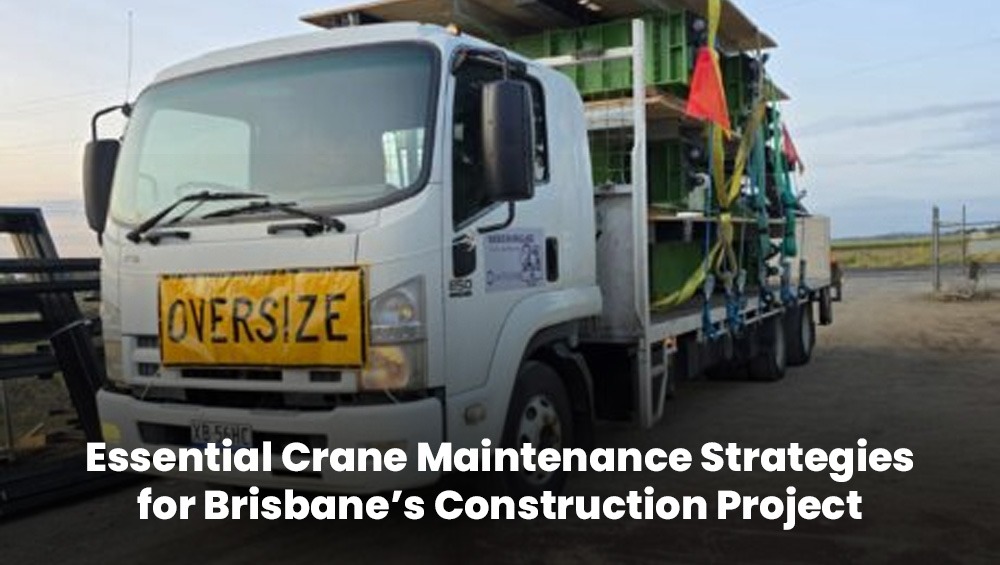Essential Crane Maintenance Strategies for Brisbane’s Construction Project
Cranes are the backbone of most construction projects, especially in a growing city like Brisbane. But using heavy machinery in this environment isn’t just about lifting weight — it’s about dealing with coastal air, shifting weather, and uneven terrain. Without regular upkeep, even the best cranes can break down when they’re needed most. That’s why maintenance isn’t just a routine — it’s a serious part of the job. From hydraulic checks to protecting systems from storms, knowing how to keep your equipment in top shape can save time, money, and most importantly, lives.
Why Crane Maintenance Matters in Brisbane
Crane maintenance isn’t just a box to tick—it’s the difference between a smooth-running site and a potentially dangerous delay. In Brisbane, where construction never stops—whether it’s high-rise towers in South Bank or heavy infrastructure. cranes are constantly under pressure. And the truth is, Brisbane’s environment is rough on machines.
The city’s subtropical environment provides excessive humidity, scorching heatwaves, and sudden electrical storms. All of these factors accelerate wear and tear on cranes.
The responsibility remains even if you hire cranes rather than owning them. Although a crane may appear to be in good condition, improper maintenance can turn it into a silent liability. Your insurance against failure is maintenance, and in a city like Brisbane, that is more important than ever.
Common Crane Issues in Brisbane Projects
Crane problems aren’t always loud or sudden—many start small and quietly snowball into something serious. And in Brisbane’s unique environment, certain issues show up more often than elsewhere. Let’s take a look at the most common ones Brisbane contractors face on-site:
1. Corrosion from Coastal Air
Although Brisbane is not directly on the beach, the salty air quickly moves inland, particularly in suburbs like Hamilton and Bynum or anywhere close to the river. Even though it is invisible, this salty moisture erodes metal joints, bolts, wire ropes, and welds. Unchecked corrosion weakens structures, making lifting loads risky.
2. Hydraulic System Failures
Hydraulic systems are stressed by Brisbane’s heatwave. Heat results in pressure drops, seals drying out or cracking, and the thinning out of hydraulic fluids. What was the outcome? Crane movement that is slower, sudden jerks, or complete system failure in the middle of operation. On a real building site, that would be horrifying.
3. Electrical System Damage from Storms
Brisbane is known for sudden storms, especially from November to March. Lightning strikes, power surges, and water ingress during storms can short out control systems, kill sensors, or mess with the boom angle indicators. Often, this kind of damage isn’t visible right away, but it leads to glitches or unresponsive systems during lifts.
4. Worn Lifting Components
Hooks, slings, ropes, and chains take the most physical stress, yet they’re the parts many overlook. After repeated lifting under harsh site conditions, they start to wear out—sometimes visibly, sometimes not. Micro-fractures and deformations slowly build up, creating a safety risk that only shows up when something fails mid-lift.
5. Outrigger and Tyre Stress
Most Brisbane construction sites aren’t flat or smooth. Cranes often operate on uneven terrain or partially soft ground. That means the outrigger system and tyres bear excessive strain to stabilize the load. Over time, this leads to cracks, imbalance, or even sinking if ground pressure isn’t properly calculated. Tyres can burst, and outriggers can fail if weight distribution isn’t constantly monitored.
In short, Brisbane’s construction environment pushes cranes to their limit. And when you’re operating in these conditions, you don’t just need any maintenance—you need the right maintenance, done on time, by people who understand the local wear factors.
Key Crane Maintenance Strategies
Now let’s dive into the most effective, field-tested crane maintenance strategies, tailored specifically for Brisbane’s construction environment.
1. Scheduled Preventive Maintenance
Routine maintenance is non-negotiable. Whether you own your crane or use a crane hire service in Brisbane, insist on service records.
Frequency Example:
- Monthly: Visual inspections and oil changes
- Quarterly: Hydraulic, brake, and cable testing
- Annually: Load testing, structural assessment, full diagnostics
2. Daily Inspections & Checklists
Operators should perform a visual and functional check at the beginning and end of each shift.
Checklist Should Include:
- Fluid levels (hydraulic, oil, coolant)
- Load hook condition
- Wire rope frays or damaged
- Brake responsiveness
- Warning lights and indicators
- Tire pressure (for mobile cranes)
3. Component-Specific Servicing
Every part of a crane has a unique wear rate. Don’t treat all components equally.
Focus Areas:
- Boom & Jib: Look for cracks or fatigue
- Wire Ropes: Replace as per the manufacturer’s discard criteria
- Brakes: Ensure responsive and calibrated
- Hydraulics: Monitor for leaks and overheating
- Outriggers/Tires: Check for level and load stability
4. Partnering with Certified Crane Technicians
Never cut corners. Hire only qualified technicians licensed under QLD regulations.
If you’re using crane hire in Brisbane, ask the provider:
- Are your cranes serviced in-house or outsourced?
- Do you follow OEM maintenance intervals?
- Can I see the last inspection report?
Local technicians understand Brisbane’s environmental demands better than anyone.
5. Using Technology for Predictive Maintenance
Smart cranes are here. Use telematics diagnostics to:
- Monitor usage hours
- Track component wear
- Detect faults before failure
Some Brisbane crane hire companies now offer predictive maintenance as a service, helping you avoid unplanned breakdowns.
Cost Benefits of Proper Crane Maintenance
Many Brisbane contractors see maintenance as a cost—but in reality, it’s a cost-saving strategy.
Here’s what you save:
- Emergency repairs
- Project delays (which affect clients and future jobs)
- Component replacements (extending crane life = ROI)
- Legal penalties or lawsuits due to accidents
Even if you’re using crane hire services in Brisbane, well-maintained cranes reduce risk on your job site.
Choosing a Crane Maintenance Provider in Brisbane
Whether you own cranes or rely on hire, selecting the right service provider is crucial.
What to Look For
- Fully licensed and insured
- 24/7 emergency response
- Mobile servicing units (for on-site repairs)
- Digital inspection reports
- Positive client testimonials in Brisbane
When using crane hire in Brisbane, always request the latest maintenance certificate and load test report for every machine.
cranes running smoothly in Brisbane isn’t about ticking boxes — it’s about staying sharp. Weather changes fast, and so does site stress. If you don’t stay ahead of maintenance, you’re risking more than just a delay — you’re risking safety, money, and your reputation. It doesn’t take a huge effort to stay on top of things. A bit of attention each day can prevent most of the big problems. That’s how you keep jobs moving and your equipment in good shape.
Read More: Mobile crane hire in Gold Coast
FAQ
1. What kind of damage does salt air do to cranes?
It slowly eats away at metal. You might not see it right away, but over time, bolts, joints, and other exposed parts start weakening.
2. What are the challenges of being a crane operator?
Managing heavy loads with precision while staying alert to safety risks, weather conditions, and equipment limitations.
3. What are the safety precautions for cranes?
Conduct regular inspections, ensure proper load limits, stabilize with outriggers, avoid working in extreme weather, and always follow site-specific safety protocols.
4. How do cranes stay stable while lifting heavy loads?
Cranes stay stable by using outriggers, counterweights, and proper load balancing on firm, level ground.
5. What is the first step in ensuring proper operation of a crane?
The first step in ensuring proper operation of a crane is conducting a thorough pre-operation inspection.

